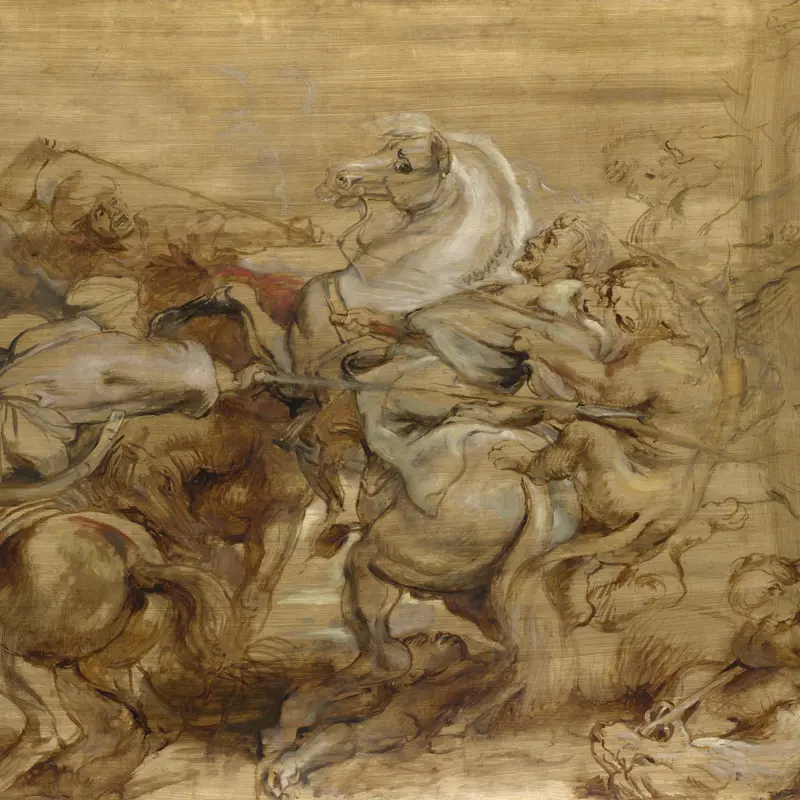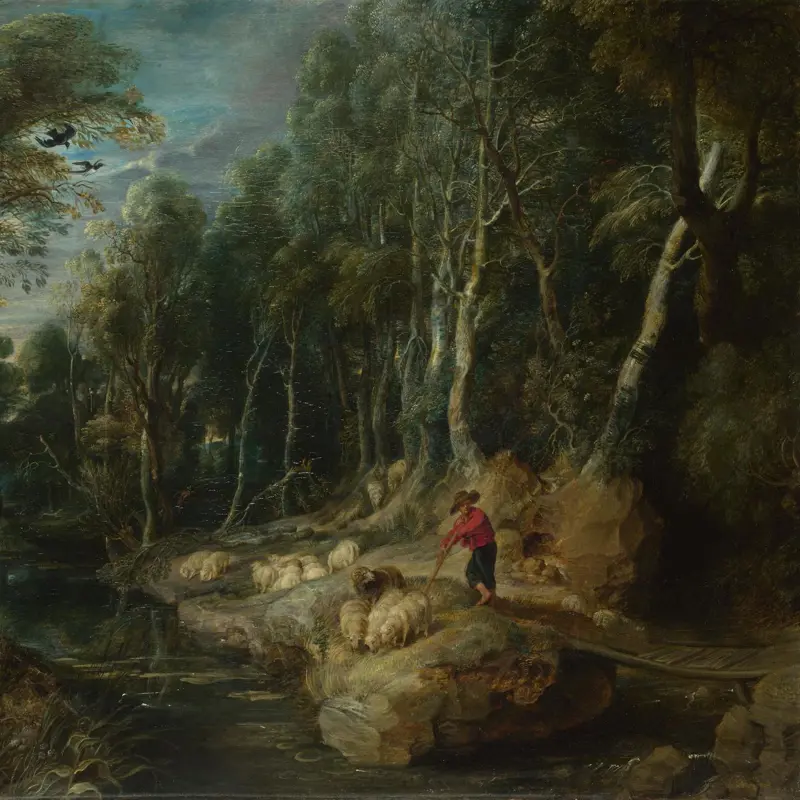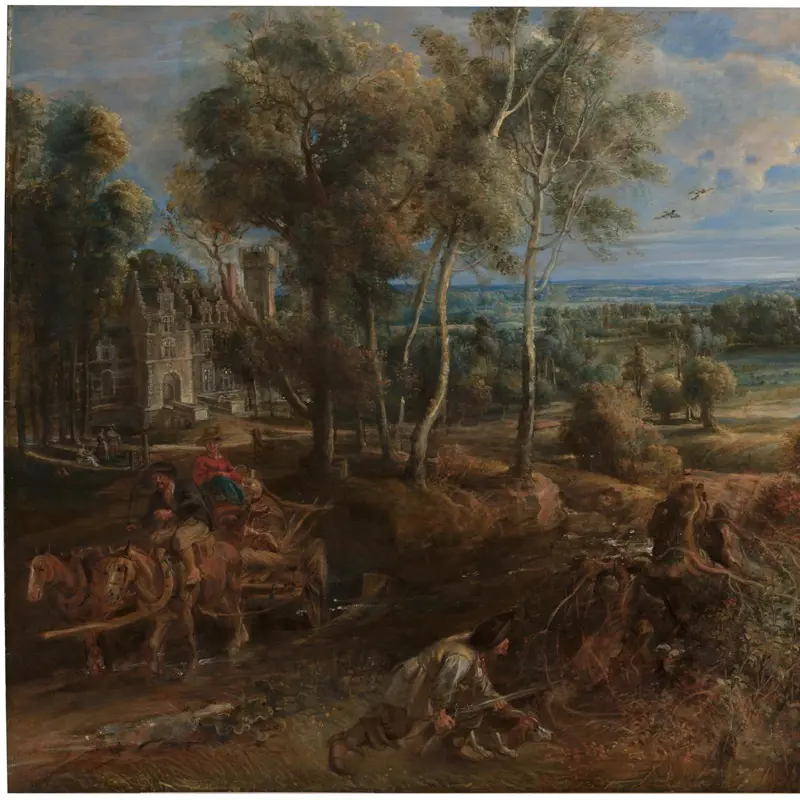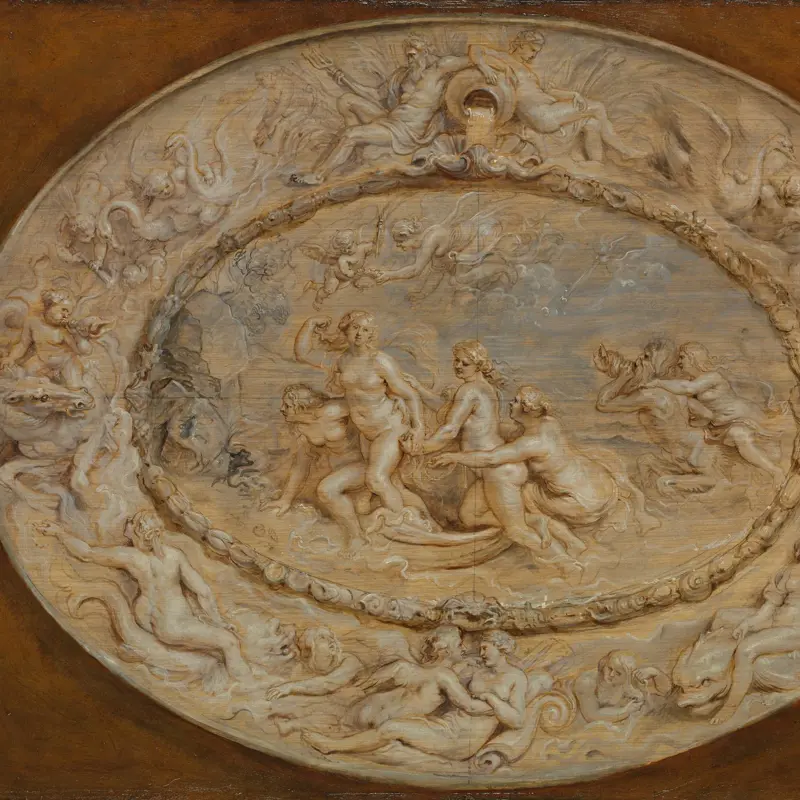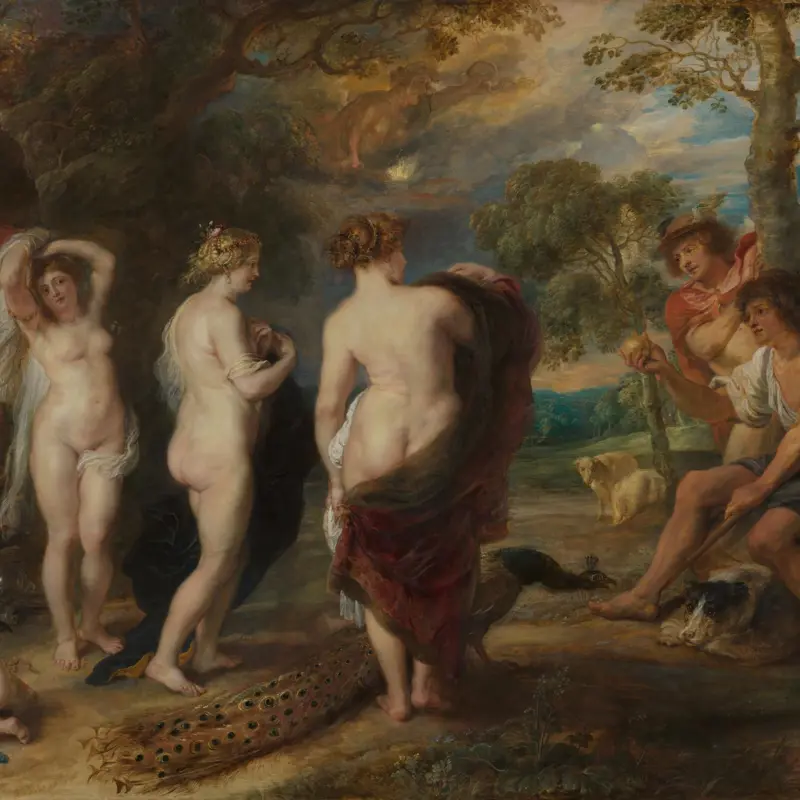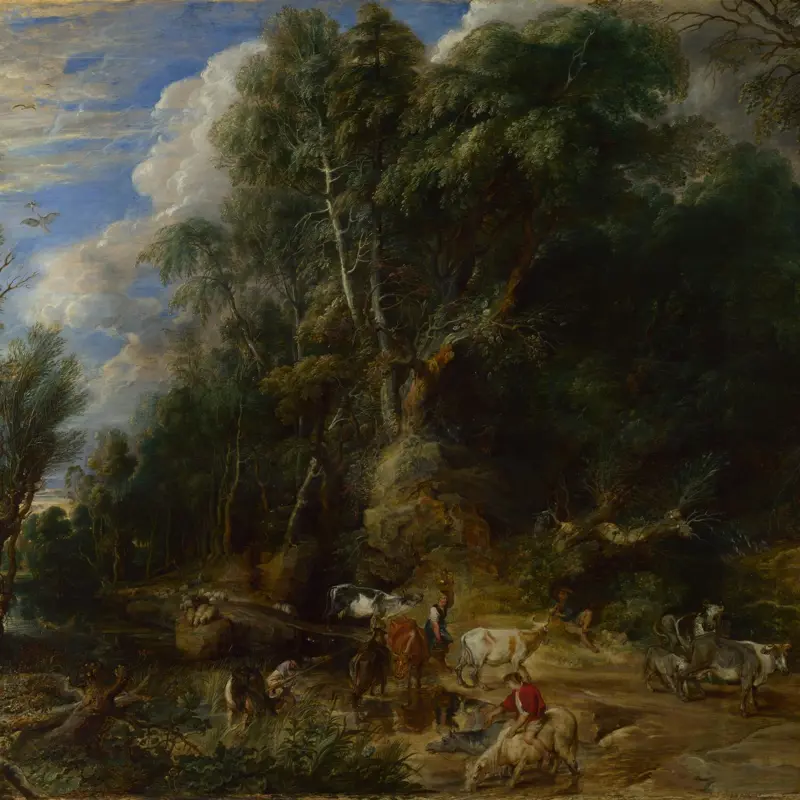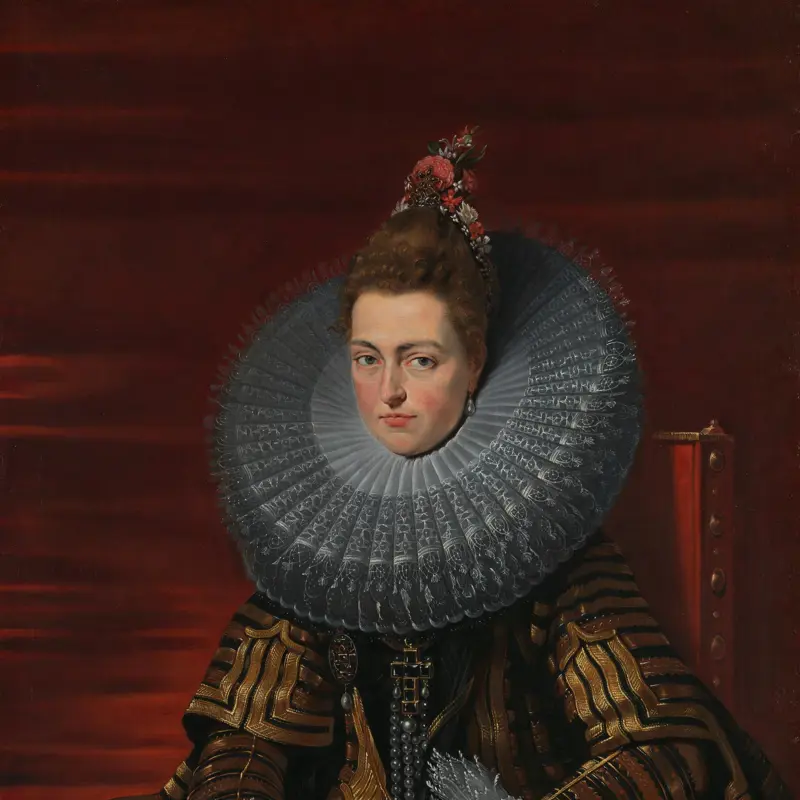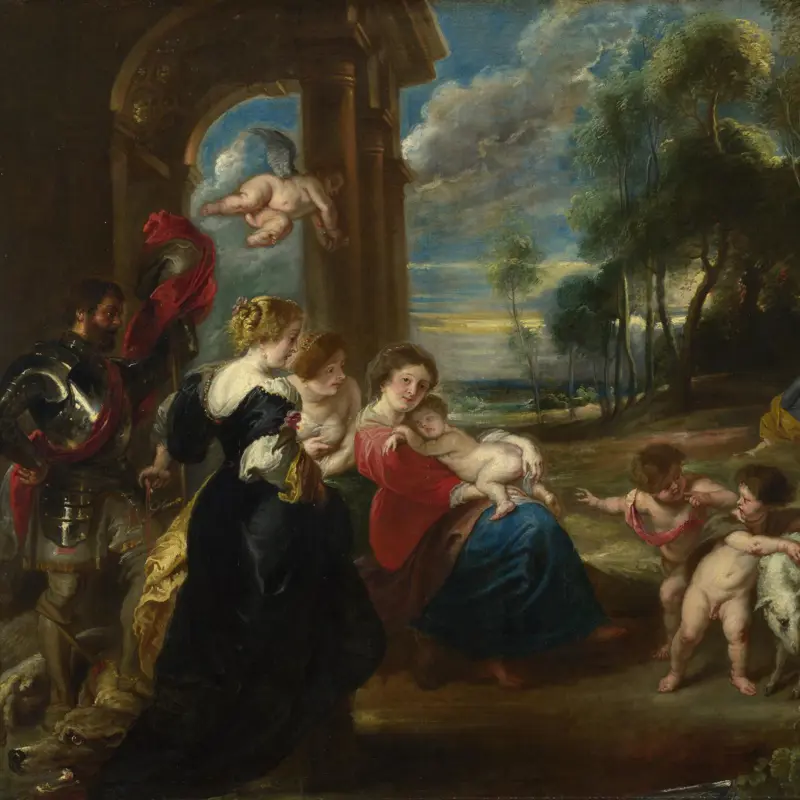Peter Paul Rubens, 'A Wagon fording a Stream', probably 1625-40
About the work
Overview
A lone driver steers his horses and wagon down a steep bank into what seems like a deep ford. It’s an idyllic scene evoking afternoon light filtering through woodland, and the subject is typical of Rubens’s burst of interest in landscape painting in the last five years of his life. Rather than paid commissions, these appear to have been made mostly for his own pleasure, when he was spending more time in the country house he bought in 1635. The countryside surrounding the estate became a new inspiration: he made about 20 landscapes, some of monumental size.
A Wagon fording a Stream is much smaller and is unfinished – you can tell this from the black chalk drafting lines and the way the foliage of most of the trees has yet to be filled in. It seems to be a full-size preparatory sketch for Evening Landscape with Timber Wagon (now in the Museum Boijmans Van Beuningen, Rotterdam).
Key facts
Details
- Full title
- A Wagon fording a Stream
- Artist
- Peter Paul Rubens
- Artist dates
- 1577 - 1640
- Date made
- Probably 1625-40
- Medium and support
- Black chalk and oil on paper, mounted on canvas
- Dimensions
- 47 × 70.5 cm
- Acquisition credit
- Wynn Ellis Bequest, 1876
- Inventory number
- NG948
- Location
- Room 20
- Collection
- Main Collection
- Previous owners
- Frame
- 17th-century French Frame
Provenance
Additional information
Text extracted from the ‘Provenance’ section of the catalogue entry in Gregory Martin, ‘National Gallery Catalogues: The Flemish School: circa 1600–circa 1900’, London 1986; for further information, see the full catalogue entry.
Exhibition history
-
2018Rubens. Painter of SketchesMuseo Nacional del Prado9 April 2018 - 5 August 2018Museum Boijmans Van Beuningen8 September 2018 - 13 January 2019
Bibliography
-
1832Christie & Manson, A Catalogue of the Genuine and Valuable Collection of Italian, French, Flemish, & Dutch Pictures of the Late Earl of Mulgrave, London, 12 May 1832
-
1886M. Rooses, L'œuvre de P. P. Rubens: Histoire et description de ses tableaux et dessins, 5 vols, Antwerp 1886-92
-
1936A. Herrmann, Untersuchungen über die Landschaftsgemälde des Peter Paul Rubens, Berlin 1936
-
1945G. Glück, Die Landschaften von P. P. Rubens, Vienna 1945
-
1953E. Haverkamp-Begemann, Olieverfschetsen van Rubens (exh. cat. Museum Boijmans Van Beuningen, 19 December 1953 - 28 February 1954), Rotterdam 1953
-
1959J. Held, Rubens: Selected Drawings, London 1959
-
1963J.T. Hayes, 'Gainsborough and Rubens', Apollo, LXXVIII/18, August 1963, pp. 89-97
-
1963L. Burchard and R.-A. d'Hulst, Rubens Drawings, Brussels 1963
-
1965M. Jaffé, 'The Literature of Art', The Burlington Magazine, 1965
-
1970G. Martin, The Flemish School, circa 1600-circa 1900, London 1970
-
1980J. Held, The Oil Sketches of Peter Paul Rubens: A Critical Catalogue, Princeton 1980
-
1980W. Adler, Jan Wildens: Der Landschaftsmitarbeiter des Rubens, Fridingen 1980
-
1982W. Adler, Landscapes and Hunting Scenes, Corpus Rubenianum Ludwig Burchard 18, vol. 1, Landscapes, London 1982
-
1986Martin, Gregory, National Gallery Catalogues: The Flemish School, circa 1600 - circa 1900, London 1986
-
1989M. Jaffé, Rubens: Catalogo completo, Milan 1989
-
1990Museum Boymans-van Beuningen 1990, Rubens en zijn tijd (exh. cat. Museum Boijmans Van Beuningen, 1990), Rotterdam 1990
-
1996C. Brown, Rubens's Landscapes (exh. cat. The National Gallery, 16 October 1996 - 19 January 1997), London 1996
-
2001
C. Baker and T. Henry, The National Gallery: Complete Illustrated Catalogue, London 2001
-
2003K. Schütz, A. Wied and K. Ertz, Die Flämische Landschaft 1520-1700, Lingen 2003
-
2004F. Healey and K.L. Belkin, A House of Art: Rubens as Collector, Antwerp 2004
-
2004H. Devisscher (ed.), De uitvinding van het landschap: Van Patinir tot Rubens 1520-1650, Antwerp 2004
-
2005E. Wiemann, M. Stocker and J. Gaschke, Die Entdeckung der Landschaft: Meisterwerke der Niederländischen Kunst des 16. & 17. Jahrhunderts, Cologne 2005
-
2014C. Kleinert, Peter Paul Rubens (1577-1640) and his Landscapes: Ideas on Nature and Art, Turnhout 2014
-
2018F. Lammertse and A. Vergara, Rubens: Painter of Sketches, Madrid 2018
About this record
If you know more about this work or have spotted an error, please contact us. Please note that exhibition histories are listed from 2009 onwards. Bibliographies may not be complete; more comprehensive information is available in the National Gallery Library.


